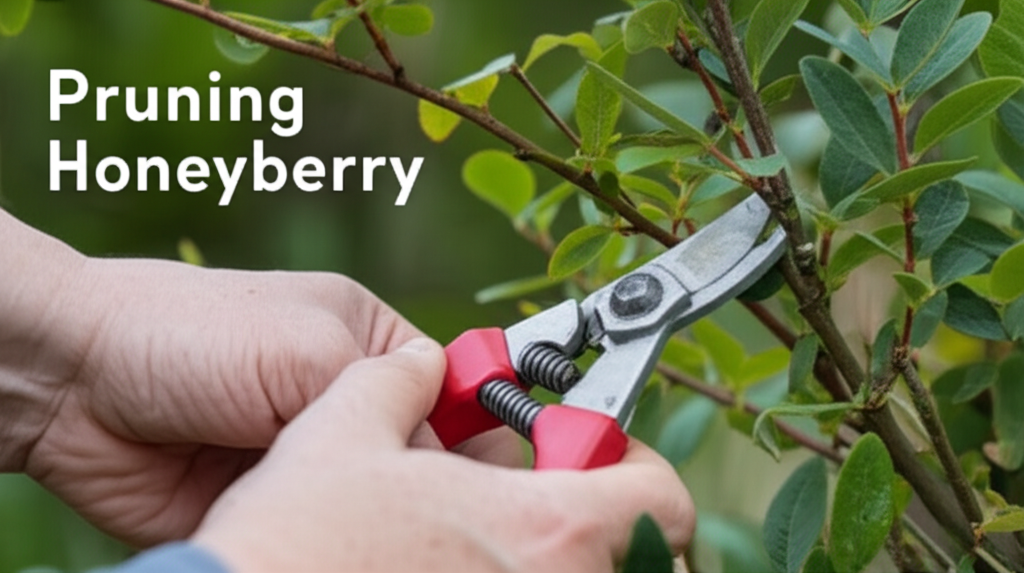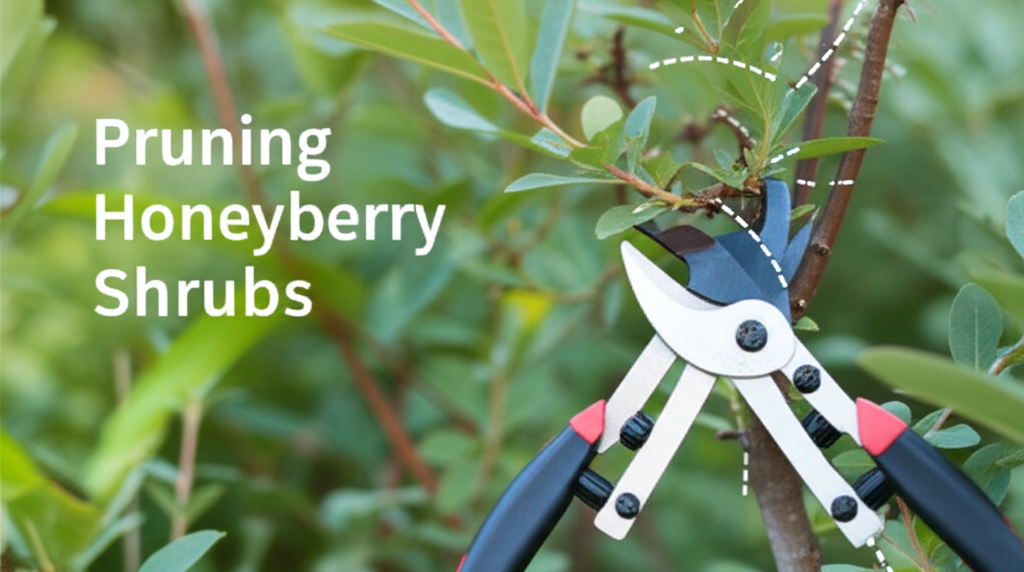Cultivating Success: Your Beginner’s Guide to Honeyberry Shrub Pruning
Honeyberries, also known as Haskaps, are gaining popularity for their resilience, early-blooming nature, and the incredibly nutritious, antioxidant-rich berries they produce. These hardy shrubs are a fantastic addition to any garden, offering a sweet and tart treat often before other fruits are even thinking about ripening. However, to maximize your honeyberry harvest and ensure the long-term health and vigor of your plants, understanding proper pruning techniques is essential. This guide is designed specifically for beginners, breaking down the process into easy-to-understand steps, demystifying the “why” behind each cut, and helping you cultivate a thriving honeyberry patch.
Understanding Why Pruning Honeyberries Matters

Pruning is not about randomly hacking away at your honeyberry shrubs; it’s a strategic horticultural practice that offers numerous benefits. For honeyberries, understanding these benefits will empower you to make informed decisions about when and how to prune.
Maximizing Fruit Production
- Encouraging New Growth: Honeyberries, like many fruit-bearing plants, produce their best fruit on younger wood. Pruning removes older, less productive stems, making way for new shoots that will bear more abundant and higher-quality fruit in the coming seasons.
- Improving Air Circulation: Overcrowded branches can lead to poor air circulation within the shrub. This creates a more humid environment, which can be a breeding ground for fungal diseases and pests. Pruning opens up the canopy, allowing air to flow freely, thus reducing the risk of disease.
- Enhancing Sunlight Penetration: Sunlight is crucial for photosynthesis and fruit development. By removing dense foliage and crossing branches, you allow sunlight to reach all parts of the plant, promoting even ripening and sweeter berries.
Maintaining Plant Health and Vigor
- Removing Dead, Diseased, or Damaged Wood: This is a fundamental aspect of any pruning. These stems are not only unproductive but can also harbor diseases and pests, posing a threat to the rest of the plant.
- Shaping the Plant: Pruning helps maintain a desirable shape, preventing the shrub from becoming unwieldy or overgrown. This makes harvesting easier and contributes to the overall aesthetic appeal of your garden.
- Preventing Overcrowding: As honeyberry shrubs mature, they can become quite dense. Pruning manages this growth, ensuring that each stem has enough space and resources to thrive.
Key Honeyberry Pruning Principles for Beginners
Before you pick up your pruning shears, familiarize yourself with these foundational principles. They will serve as your compass as you begin your honeyberry pruning journey.
The “Three D’s” Rule
This is arguably the most important rule in pruning any plant, and honeyberries are no exception. Always start by identifying and removing:
- Dead: Stems that are brittle, discolored, and show no signs of life.
- Diseased: Stems exhibiting unusual spots, wilting, or cankers.
- Damaged: Broken, cracked, or rubbed branches.
The Importance of Timing
When you prune your honeyberries can significantly impact their growth and fruiting.
- Late Winter/Early Spring: This is the primary and most recommended time for pruning honeyberries. Pruning should occur after the harshest winter cold has passed but before significant new growth begins. This allows you to clearly see the plant’s structure and minimize stress on the plant. Pruning during this period also encourages vigorous new growth for the upcoming fruiting season.
- Post-Harvest (Light Pruning): You can perform very light pruning immediately after harvesting your berries. This is usually to remove any spent fruit clusters or very minor shaping. Avoid heavy pruning at this time as it can stress the plant and potentially impact the following year’s bloom.
Tools of the Trade
Using the right tools makes the job easier, safer, and results in cleaner cuts, which are better for the plant’s recovery.
- Bypass Pruners: Ideal for making clean cuts on stems up to about ¾ inch in diameter. They work like scissors, with two curved blades that bypass each other.
- Loppers: For thicker branches (¾ inch to 1.5 inches in diameter). The longer handles provide leverage for easier cutting.
- Pruning Saw: For branches larger than 1.5 inches. Essential for removing older, thicker wood.
Always ensure your tools are sharp and clean before use. Disinfecting them between plants can prevent the spread of diseases.
A Step-by-Step Approach to Honeyberry Pruning
Now, let’s get practical. Follow these steps to prune your honeyberry shrubs effectively.
Step 1: Assess Your Honeyberry Shrub
Before making any cuts, take a step back and observe your honeyberry plant.
- Identify the overall structure.
- Look for any obviously dead, diseased, or damaged branches.
- Note any crossing or rubbing branches.
- Consider the age of the branches – younger, vigorous stems are often a lighter brown and more flexible, while older wood can be darker, thicker, and sometimes cracked.
Step 2: Remove the “Three D’s”
Using your clean and sharp tools, start by removing all dead, diseased, and damaged wood. Make cuts back to healthy tissue. If you’re unsure if a branch is dead, you can scratch away a small section of the bark with your fingernail; if there’s green underneath, it’s alive.
Step 3: Address Crossing and Rubbing Branches
Branches that cross or rub against each other can create wounds that are entry points for disease and can damage the bark. Remove one of the offending branches, typically the weaker or poorly positioned one. Aim to make the cut at the point where the branch originates from the main stem or a larger branch.
Step 4: Thin Out Overcrowded Areas
Honeyberry shrubs can become very dense, especially as they mature. This is where you’ll focus on improving air circulation and light penetration.
- Identify stems growing inward towards the center of the shrub.
- Remove some of the weaker, spindly shoots that are competing for resources.
- Aim to create a more open, vase-like structure.
Step 5: Remove Old, Non-Productive Wood (Older Plants)
Honeyberries typically produce their best fruit on wood that is 2-4 years old. Wood older than this, often darker and thicker, tends to be less productive and can overcrowd newer growth.
- Identify the oldest, thickest stems.
- Select a few of these to remove each year, cutting them back to the ground or to a strong lateral branch.
- This process, known as rejuvenation pruning, encourages the growth of new, more fruitful stems from the base of the plant.
Step 6: Shape the Plant (Optional)
Once the essential pruning is done, you can do some light shaping to maintain a desirable size and form.
- Trim back any branches that are growing too tall or are sticking out awkwardly.
- Aim to maintain a rounded or slightly vase-shaped appearance.
- Keep in mind that you are aiming to remove about 10-20% of the shrub’s total canopy each year. Over-pruning can significantly reduce your harvest.
Pruning Young Honeyberry Shrubs (First 3-4 Years)
The pruning approach for young honeyberry shrubs is different from mature ones. The focus here is on establishing a strong, well-branched structure that will support future harvests.
Year 1: Focus on Establishment
- After planting, prune your young honeyberry back by about one-third to encourage branching.
- Remove any damaged roots or branches that occurred during transplanting.
- The primary goal is to get the plant established and encourage a strong root system. Avoid any heavy pruning.
Year 2-3: Building Structure
- Begin to establish a central leader or a few dominant main stems.
- Remove any suckers that emerge from the base of the plant unless you want to encourage a bushier habit.
- Remove branches that are growing downwards or inward.
- Start to remove the weakest shoots to allow stronger ones to develop.
Year 4 Onwards: Mature Plant Pruning
From the fourth year onward, you can begin implementing the pruning techniques for mature plants described earlier, focusing on rejuvenation and thinning to maintain productivity.
Common Mistakes to Avoid
Even with the best intentions, beginners can sometimes make common pruning mistakes. Being aware of these will help you avoid them.
Mistake 1: Pruning at the Wrong Time
- Over-pruning in late summer/fall: This can stimulate new growth that won’t harden off before winter, making the plant susceptible to frost damage. It also removes potential fruiting buds for the next season.
Mistake 2: Over-Pruning
- Removing too much wood: Honeyberries fruit on 2-4 year old wood. Removing too much of this can drastically reduce your harvest for the next couple of years. Remember the 10-20% rule for mature plants.
Mistake 3: Making “Stubs”
- Leaving short, stubby branches: Cuts should be made just above a bud that is pointing outward, or back to a stronger branch or the main stem. Leaving stubs can lead to dieback and is an entry point for disease.
Mistake 4: Using Dull or Dirty Tools
- Crushing stems instead of cutting: This damages the vascular system of the plant, hindering healing and increasing the risk of disease.
Troubleshooting Common Honeyberry Pruning Issues
As you gain experience, you might encounter some specific scenarios. Here’s how to address them.
Issue: My Honeyberry is Too Leggy and Sparse
- Cause: Insufficient pruning in previous years, leading to weak, elongated growth.
- Solution: In late winter, perform a more aggressive thinning. Remove about 20-25% of the oldest, least productive stems right at the base. Also, remove about half of the weaker, spindly shoots. This will encourage stronger, bushier growth from the lower parts of the plant.
Issue: My Honeyberry is Not Producing Many Berries
- Cause: Several factors could be at play, including lack of cross-pollination, insufficient sunlight, or old, unproductive wood.
- Solution:
- Ensure you have at least two different honeyberry varieties planted nearby for cross-pollination, as most varieties require a pollenizer.
- If the plant is very dense, prune to improve light penetration and air circulation as outlined in the “Thin Out Overcrowded Areas” section.
- If the plant is old and overgrown, conduct rejuvenation pruning by removing a few of the oldest, thickest stems each year.
Honeyberry Pruning: A Comparative Overview
Understanding how honeyberry pruning differs from other common berry bushes can provide valuable context.
| Feature | Honeyberry | Blueberry | Raspberry |
|---|---|---|---|
| Best Time to Prune | Late Winter/Early Spring | Late Winter/Early Spring | After Fruiting (Summer-bearing) / Late Winter (Ever-bearing) |
| Fruiting Wood | 2-4 year old wood | 3-4 year old wood | Primocanes (new growth) for ever-bearing, Floricanes (second year growth) for summer-bearing |
| Primary Pruning Goal | Thinning, rejuvenation, light shaping | Rejuvenation of old wood, thinning | Removal of spent canes, thinning of new canes |
| Aggressiveness | Moderate; aim to remove 10-20% of canopy | Can be more aggressive with rejuvenation pruning | Aggressive removal of old canes, selective thinning of new ones |
Honeyberry Pruning: Pros and Cons
Like any horticultural practice, pruning has its advantages and disadvantages.
| Pros | Cons |
|---|---|
| Increased fruit yield and quality | Can reduce harvest in the immediate year if overdone |
| Improved plant health and disease resistance | Requires proper timing and technique to be effective |
| Better air circulation and sunlight penetration | Requires investment in proper tools |
| Easier harvesting due to improved structure | Can be intimidating for beginners initially |
| Maintains plant vigor and longevity | Improper cuts can damage the plant |
Conclusion: Pruning for a Bountiful Future
Pruning your honeyberry shrubs may seem daunting at first, but by understanding the core principles and following these step-by-step techniques, you’ll be well on your way to cultivating a productive and healthy berry patch. Remember to start with the “Three D’s,” prune at the right time, use sharp tools, and gradually work towards a balanced, open structure. With each year, you’ll gain confidence, and your honeyberry shrubs will reward you with increasingly abundant and delicious harvests. Happy pruning!


